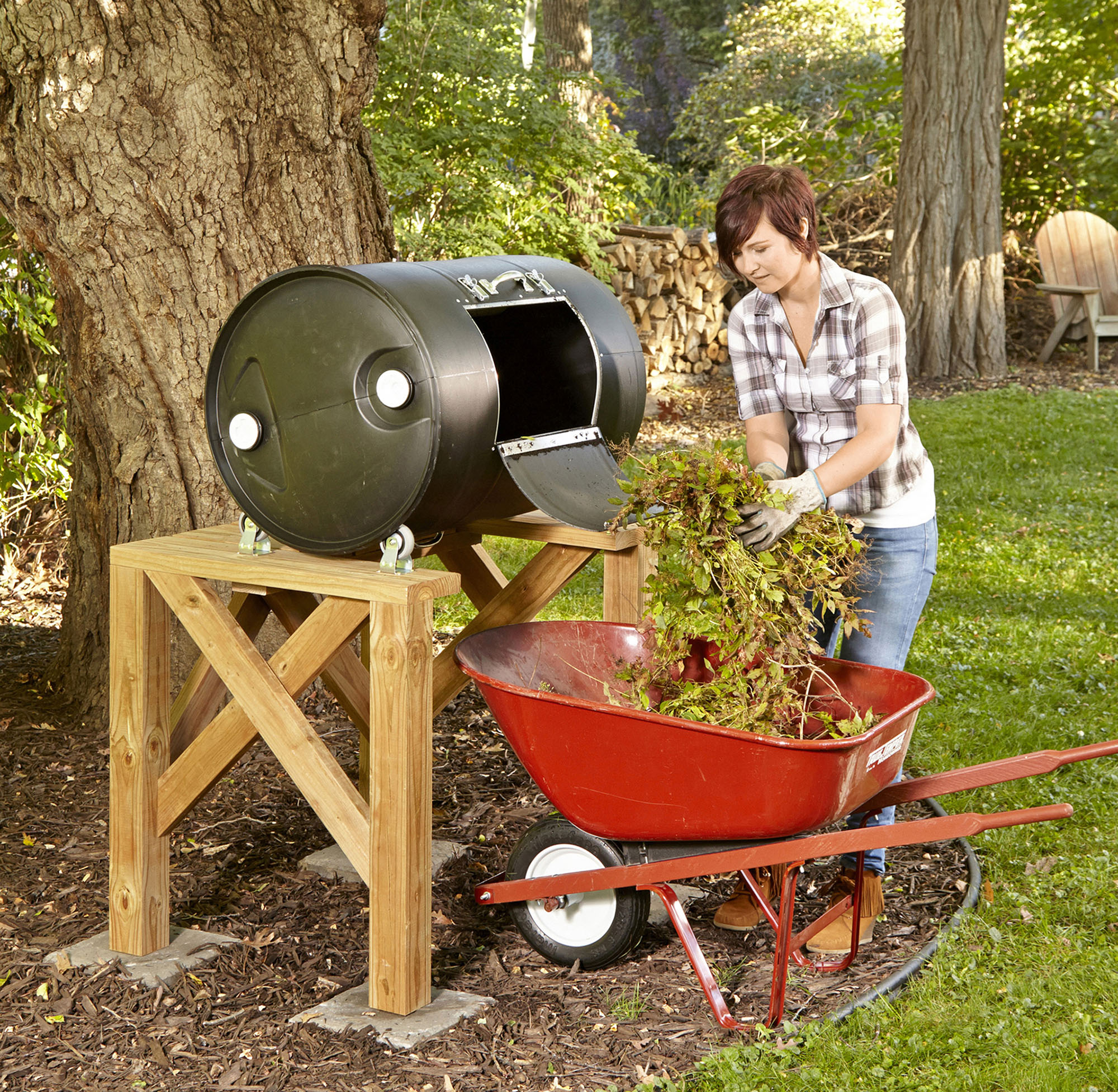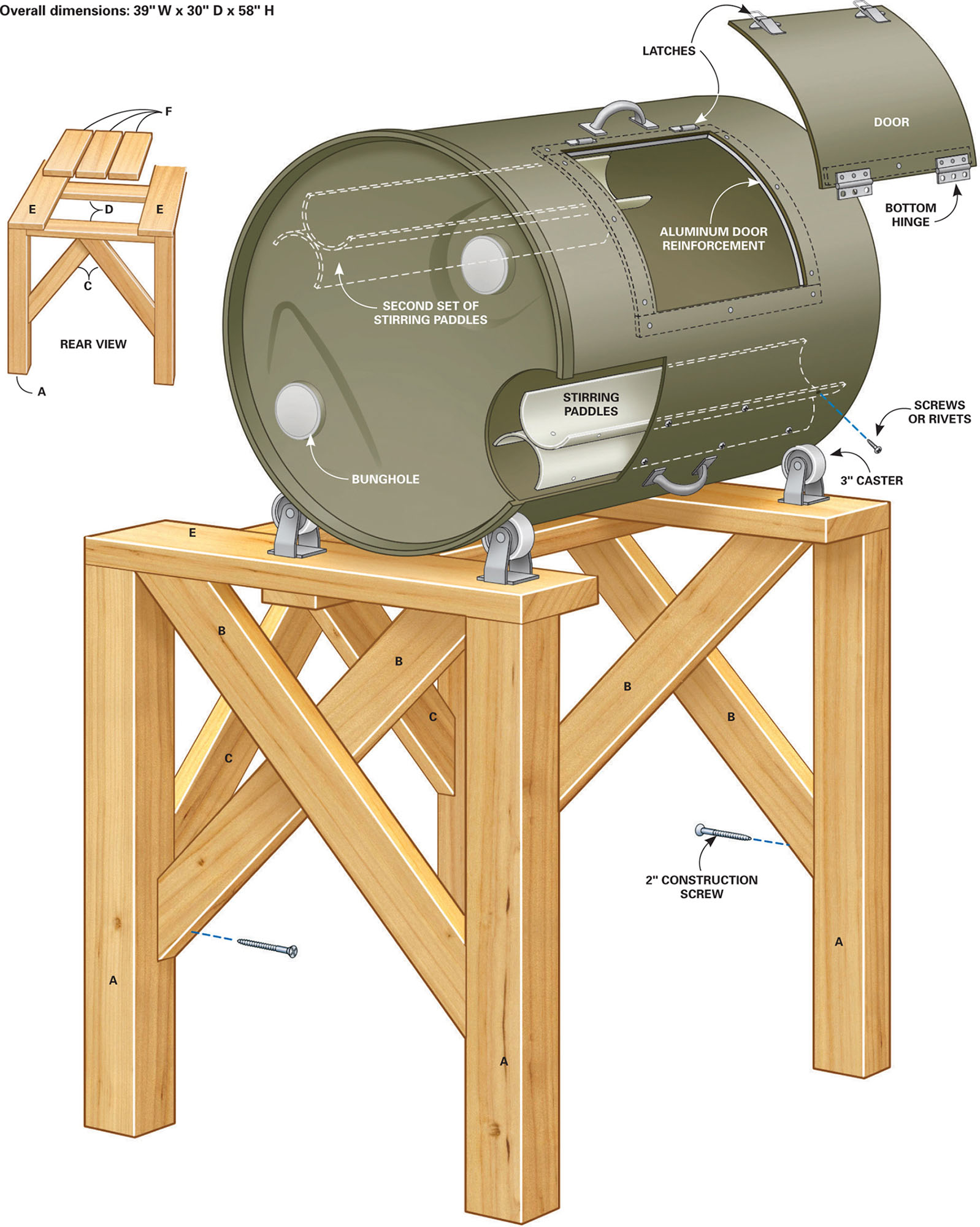

WHAT IT TAKES
TIME: 1 day
SKILL LEVEL: Intermediate
Drum composters convert yard waste to finished compost much faster than stationary compost bins do because they allow you to churn and instantly aerate the waste. Plus, drum composters are easier on your back. You can buy them online or at any garden center in a wide range of sizes and prices. But they all follow the same basic design—a drum on a stand. Our version is an adaptation of that, using a plastic 55-gallon drum. The drum and stand together cost about the same as the low-price models, but our composter is built stronger and has more features. It takes a full day to customize the drum and build the stand. We used rivets to speed up the assembly, but screws, nuts and lock washers work too.
Ask for free used 55-gallon polyethylene drums at car washes and food processing and industrial manufacturers. Since beggars can’t be choosers, you’ll probably wind up with a white, green or blue drum. If that doesn’t fit your backyard color scheme (paint doesn’t stick well to polyethylene), contact a container firm and order the color you want. We ordered a black “tight-head” drum (top permanently sealed to the drum) from a local supplier.
Next, use a jigsaw to cut a door panel slightly smaller than the width of your wheelbarrow. The next step takes the most time and isn’t mandatory, but it adds strength and stability to the entire door assembly: Bend 1/8-in. x 1-in. flat aluminum stock around the drum to form side reinforcements for the door opening. Cut the bent aluminum slightly longer than the door opening and mount it to the drum (Photo 1).
Then cut flat aluminum pieces for the top and bottom of the door opening and the hinge side of the door. Mount the top and bottom door opening reinforcements in the same manner. Mount the hinges at the bottom of the door opening so the door hangs down when you empty the drum. Finish the door by adding the latches (Figure A).
To make stirring paddles, cut an 8-ft. piece of 4-in. PVC pipe in half lengthwise using a jigsaw. Cut the halves to length so they’re slightly shorter than the inside height of the drum. Arrange two halves back-to-back. Then drill and screw the pieces together to form one paddle unit. The back-to-back design is stronger than a single “scoop” and allows you to rotate the drum in either direction. Repeat for the second paddle unit.
Since the drum has a taper at the top and bottom, you’ll have to sand the ends of the paddles to match (Photo 2). Mount the paddle units 180 degrees apart and secure them to the drum with screws, nuts and washers. Finally, mount grab handles around the drum to help you rotate it.
A tight-head drum comes with two threaded “bungholes.” Remove the threaded caps to provide ventilation. You may need to drill additional ventilation holes if the mixture stays too wet.
Cut the legs and deck boards to length according to the Cutting List. Then assemble the stand using a drill and exterior screws (Photo 3). Add diagonal struts to prevent front-to-back and side-to-side movement when spinning the drum.
Flip the stand upright and mount two casters so they ride in the recess around the drumhead. Then level the drum and mount the remaining two casters (Photo 4).
Load the drum with yard waste and add a compost starter to get the batch cooking (sold at any home or garden center). Rotate at least once every day to mix and aerate the batch. When the compost is ready, just dump it out.
Figure A
Drum composter

Materials list
ITEM |
QTY. |
12' 4x4 treated lumber |
1 |
8' 2x4 treated lumber |
3 |
10' 2x8 treated lumber |
1 |
6' of 4" PVC pipe |
|
Rivets (aluminum), nuts and bolts (stainless steel), hinges, handles, 1" flat aluminum stock, latches, exterior screws, 3" casters.
Cutting list
KEY. |
QTY. |
SIZE & DESCRIPTION |
A |
4 |
4x4 x 32-1/2" (legs) |
B |
4 |
2x4 x 32-3/8" (side braces; cut at 45-degree angle, long point to long point) |
C |
2 |
2x4 x 30" (back braces; cut at 45-degree angle, long point to long point) |
D |
2 |
2x4 x 32" (cross braces) |
E |
2 |
2x8 x 30" (drum deck) |
F |
3 |
2x8 x 13-1/2" (deck, evenly spaced; optional) |